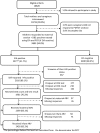Missed Opportunities along the Prevention of Mother-to-Child Transmission Services Cascade in South Africa: Uptake, Determinants, and Attributable Risk (the SAPMTCTE)
- PMID: 26147598
- PMCID: PMC4492960
- DOI: 10.1371/journal.pone.0132425
Missed Opportunities along the Prevention of Mother-to-Child Transmission Services Cascade in South Africa: Uptake, Determinants, and Attributable Risk (the SAPMTCTE)
Abstract
Objectives: We examined uptake of prevention of mother-to-child HIV transmission (PMTCT) services, predictors of missed opportunities, and infant HIV transmission attributable to missed opportunities along the PMTCT cascade across South Africa.
Methods: A cross-sectional survey was conducted among 4-8 week old infants receiving first immunisations in 580 nationally representative public health facilities in 2010. This included maternal interviews and testing infants' dried blood spots for HIV. A weighted analysis was performed to assess uptake of antenatal and perinatal PMTCT services along the PMTCT cascade (namely: maternal HIV testing, CD4 count test/result, and receiving maternal and infant antiretroviral treatment) and predictors of dropout. The population attributable fraction associated with dropouts at each service point are estimated.
Results: Of 9,803 mothers included, 31.7% were HIV-positive as identified by reactive infant antibody tests. Of these 80.4% received some form of maternal and infant antiretroviral treatment. More than a third (34.9%) of mothers dropped out from one or more steps in the PMTCT service cascade. In a multivariable analysis, the following characteristics were associated with increased dropout from the PMTCT cascade: adolescent (<20 years) mothers, low socioeconomic score, low education level, primiparous mothers, delayed first antenatal visit, homebirth, and non-disclosure of HIV status. Adolescent mothers were twice (adjusted odds ratio: 2.2, 95% confidence interval: 1.5-3.3) as likely to be unaware of their HIV-positive status and had a significantly higher rate (85.2%) of unplanned pregnancies compared to adults aged ≥20 years (55.5%, p = 0.0001). A third (33.8%) of infant HIV infections were attributable to dropout in one or more steps in the cascade.
Conclusion: A third of transmissions attributable to missed opportunities of PMTCT services can be prevented by optimizing the uptake of PMTCT services. Identified risk factors for low PMTCT service uptake should be addressed through health facility and community-level interventions, including raising awareness, promoting women education, adolescent focused interventions, and strengthening linkages/referral-system between communities and health facilities.
Conflict of interest statement
Figures
References
-
- Marazzi, M., G. Liotta, J. Haswell, I. Zimba, K. Nielsen-Saines, M. Maulidi, et al. Extended use of highly active antiretroviral therapy (HAART) during pregnancy in Southern Africa is highly protective in HIV-1 prevention of mother-to-child-transmission (PMTCT) also in women with higher CD4 cell counts. in 5th International AIDS Society Conference on HIV Pathogenesis, Treatment and Prevention. 2009 Cape Town, South Africa.
-
- Kesho Bora Study Group. Triple antiretroviral compared with zidovudine and single-dose nevirapine prophylaxis during pregnancy and breastfeeding for prevention of mother-to-child transmission of HIV-1 (Kesho Bora study): a randomised controlled trial. Lancet InfectDis, 2011. 11(3): p. 171–80. - PubMed
-
- Global report: UNAIDS report on the global AIDS epidemic 2013.
Publication types
MeSH terms
Substances
Grants and funding
LinkOut - more resources
Full Text Sources
Other Literature Sources
Medical
Research Materials



